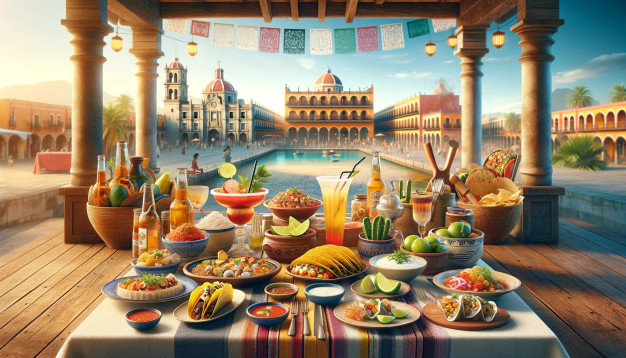Gastronomy of Mexico Food & Beverage guide for first time travelers
Dive into Mexico's culinary scene: explore street food, regional dishes, and local drinks.

Introduction to Mexican Gastronomy
The Rich Heritage of Mexican Cuisine
Mexican gastronomy, a UNESCO Intangible Cultural Heritage, is a vibrant tapestry woven from indigenous traditions and Spanish colonial influences. This fusion has created a cuisine noted for its variety of flavors, colors, and textures, appealing to both the humble palate and the connoisseur’s taste.
Understanding Mexican Food Culture
Mexican food culture is all about community and celebration. Meals are often shared, with dishes placed at the center of the table. Street food is a way of life, and local markets (mercados) are the beating heart of culinary exploration.
Essential Dishes to Try
Tacos and Their Many Variations
Tacos, the poster child of Mexican cuisine, are as diverse as the country itself. From tacos al pastor with its shawarma-inspired spit-grilled pork to the simplicity of tacos de canasta – basket tacos steamed to perfection, there’s a taco for every taste bud.
Mole: Mexico’s Signature Sauce
Mole is the masterpiece sauce of Mexican cuisine. It’s a complex blend of chilies, spices, and sometimes chocolate, creating a depth of flavor that’s truly unparalleled. Each region boasts its own version, from Mole Poblano to the fiery Mole Negro of Oaxaca.
Street Food Staples: Elotes and Tamales
Elotes, grilled corn slathered in creamy, spicy goodness, are a must-try. Tamales, on the other hand, offer a comforting bundle of masa (corn dough) filled with anything from pork to sweet pineapple, all wrapped in a corn husk or banana leaf.
Seafood Delights: From Ceviche to Camarones
The coastal regions serve up an ocean of flavors. Ceviche, fresh fish "cooked" in lime juice and spiked with chili, and camarones (shrimp) in all forms – from aguachile to a la diabla – are just the tip of the iceberg.
Must-Experience Beverages
Tequila and Mezcal: Beyond the Shot
Tequila and mezcal, Mexico’s iconic spirits, are to be sipped and savored, not slammed. Discover the nuanced flavors of these agave-based liquors, and you’ll never look at a shot glass the same way again.
Traditional Non-Alcoholic Drinks: Horchata and Aguas Frescas
Horchata, a refreshing rice-based drink, and aguas frescas, fresh fruit waters, offer sweet respite from the heat. Flavors like tamarindo, jamaica (hibiscus), and limón are ubiquitous.
The Craft of Mexican Beer
The Mexican beer scene has surged beyond the typical lagers. Artisanal breweries are crafting everything from bold stouts to fruity ales, proving that Mexican cerveza isn’t just a beachside companion.
Regional Specialties and Where to Find Them
Northern Mexico: Carnes Asadas and Flour Tortillas
In Northern Mexico, the art of grilling meat is serious business. Carnes asadas are often accompanied by thick, pillowy flour tortillas – a perfect pairing for a carnivorous indulgence.
Southern Mexico: Chocolate and Chapulines
Southern Mexico delights with its rich, indigenous chocolate, often enjoyed as a drink. Adventurous eaters can also sample chapulines, spicy, crunchy grasshoppers that are a protein-packed snack.
Coastal Regions: A Seafood Paradise
Seafood aficionados rejoice in coastal areas where the catch of the day is served up in ceviches, tacos, and everything in between. The freshness is unparalleled, the flavors, unforgettable.
Food Etiquette and Tips for Travelers
Meal Times and Local Dining Customs
Mexicans typically eat late. Lunch, the main meal, can start as late as 3 PM, while dinner often doesn’t begin until after 8 PM. Embrace the leisurely pace of dining; it’s part of the experience.
Tipping Practices in Mexican Restaurants
Tipping is customary – typically 10-15% in restaurants. If service is included in the bill, a little extra for outstanding service is always appreciated.
Navigating Street Food and Markets
How to Spot the Best Street Food Vendors
The best street food vendors often have long lines of locals. Look for high turnover, a sign of freshness, and vendors who specialize in just one or two dishes – they’re likely masters of their craft.
Exploring Local Mercados for Authentic Flavors
Dive into the sensory overload of Mexican mercados. They’re a goldmine for tasting regional specialties. From ripe produce to sizzling comals (griddles), markets are a window into the soul of Mexican cuisine.
Mexican Gastronomy Beyond the Plate
Food Festivals and Culinary Events
Seek out food festivals and culinary events. They’re festive, flavorful showcases of regional cuisines and offer a chance to rub elbows with local chefs and fellow food enthusiasts.
Cooking Classes and Gastronomic Tours
For a hands-on approach, enroll in a cooking class or embark on a gastronomic tour. There’s no better souvenir than the ability to recreate the flavors of Mexico at home.
Conclusion
Embracing the Full Spectrum of Mexican Cuisine
Mexican cuisine is a rich, diverse, and utterly delicious tapestry. Whether you’re a first-timer or a seasoned visitor, every trip can offer new flavors, dishes, and culinary adventures. Eat widely, eat well, and let the vibrant spirit of Mexico’s gastronomy be your guide.